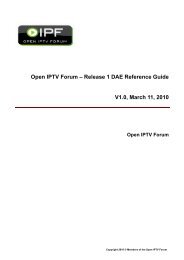OIPF Release 2 Specification Specification ... - Open IPTV Forum
OIPF Release 2 Specification Specification ... - Open IPTV Forum
OIPF Release 2 Specification Specification ... - Open IPTV Forum
- No tags were found...
Create successful ePaper yourself
Turn your PDF publications into a flip-book with our unique Google optimized e-Paper software.
<strong>OIPF</strong><strong>Release</strong> 2 <strong>Specification</strong>Volume 2 – Media Formats[V2.0] – [20102010-0909-07]<strong>Open</strong> <strong>IPTV</strong> <strong>Forum</strong>
Page 2 (29)<strong>Open</strong> <strong>IPTV</strong> <strong>Forum</strong>Postal address<strong>Open</strong> <strong>IPTV</strong> <strong>Forum</strong> support office address650 Route des Lucioles – Sophia AntipolisValbonne – FRANCETel.: +33 4 92 94 43 83Fax: +33 4 92 38 52 90Internethttp://www.oipf.tvDisclaimerThe <strong>Open</strong> <strong>IPTV</strong> <strong>Forum</strong> members accept no liability whatsoever for any use of this document.This specification provides multiple options for some features. The <strong>Open</strong> <strong>IPTV</strong> <strong>Forum</strong> Profiles specificationcomplements the <strong>Release</strong> 2 specifications by defining the <strong>Open</strong> <strong>IPTV</strong> <strong>Forum</strong> implementation and deployment profiles.Any implementation based on <strong>Open</strong> <strong>IPTV</strong> <strong>Forum</strong> specifications that does not follow the Profiles specification cannotclaim <strong>Open</strong> <strong>IPTV</strong> <strong>Forum</strong> compliance.Copyright NotificationNo part may be reproduced except as authorized by written permission.Any form of reproduction and/or distribution of these works is prohibited.Copyright © 2010, <strong>Open</strong> <strong>IPTV</strong> <strong>Forum</strong> e.V.Copyright 2010 © <strong>Open</strong> <strong>IPTV</strong> <strong>Forum</strong> e.V.
Page 3 (29)ContentsFOREWORD ...................................................................................................................................................................... 6INTRODUCTION .............................................................................................................................................................. 71 REFERENCES ........................................................................................................................................................... 81.1 NORMATIVE REFERENCES ................................................................................................................................... 81.1.1 Standard References ...................................................................................................................................... 81.1.2 <strong>Open</strong> <strong>IPTV</strong> <strong>Forum</strong> References .................................................................................................................... 101.2 INFORMATIVE REFERENCES .............................................................................................................................. 102 CONVENTIONS AND TERMINOLOGY ............................................................................................................. 112.1 CONVENTIONS .................................................................................................................................................... 112.2 TERMINOLOGY ................................................................................................................................................... 112.2.1 Definitions .................................................................................................................................................. 112.2.2 Abbreviations .............................................................................................................................................. 113 A/V MEDIA FORMATS .......................................................................................................................................... 124 SYSTEMS LAYER ................................................................................................................................................... 154.1 MPEG-2 TRANSPORT STREAM ......................................................................................................................... 154.2 MP4 FILE FORMAT ............................................................................................................................................ 164.3 SERVICE USAGE ................................................................................................................................................. 175 VIDEO ....................................................................................................................................................................... 185.1 FORMATS ............................................................................................................................................................ 185.1.1 High Definition Profile ............................................................................................................................... 185.1.1.1 H.264/AVC...................................................................................................................................................................... 185.1.1.2 MPEG-2 .......................................................................................................................................................................... 185.1.2 Standard Definition Profile ......................................................................................................................... 185.1.2.1 H.264/AVC...................................................................................................................................................................... 185.1.2.2 MPEG-2 .......................................................................................................................................................................... 195.1.3 Video Telephony Profile ............................................................................................................................. 195.1.3.1 H.264/AVC...................................................................................................................................................................... 195.1.3.2 MPEG-4 Part-2 Visual ................................................................................................................................................... 195.1.3.3 H.263 .............................................................................................................................................................................. 195.1.4 Sub-Picture Profile ...................................................................................................................................... 195.1.4.1 H.264/AVC...................................................................................................................................................................... 205.1.4.2 MPEG-2 .......................................................................................................................................................................... 205.1.5 Video formats for A/V content provided to Mobile Terminals ................................................................... 205.1.5.1 H.263 .............................................................................................................................................................................. 205.1.5.2 H.264/AVC...................................................................................................................................................................... 205.1.5.3 MPEG-4 Part-2 Visual ................................................................................................................................................... 205.1.6 H.264/AVC GOP Structure......................................................................................................................... 205.2 SERVICE USAGE ................................................................................................................................................. 216 SUBTITLES .............................................................................................................................................................. 226.1 FORMATS ............................................................................................................................................................ 226.2 SERVICE USAGE ................................................................................................................................................. 227 TELETEXT ............................................................................................................................................................... 237.1 FORMATS ............................................................................................................................................................ 237.2 SERVICE USAGE ................................................................................................................................................. 238 AUDIO ....................................................................................................................................................................... 248.1 FORMATS ............................................................................................................................................................ 258.1.1 HE-AAC and AAC ..................................................................................................................................... 258.1.1.1 A/V content ..................................................................................................................................................................... 258.1.1.2 Audio clips ...................................................................................................................................................................... 258.1.1.3 HE-AAC metadata .......................................................................................................................................................... 258.1.2 AC-3 ........................................................................................................................................................... 258.1.3 Enhanced AC-3 ........................................................................................................................................... 258.1.4 MPEG-1 Layer II ........................................................................................................................................ 258.1.5 MPEG-1 Layer III ....................................................................................................................................... 26Copyright 2010 © <strong>Open</strong> <strong>IPTV</strong> <strong>Forum</strong> e.V.
Page 4 (29)8.1.6 WAVE ........................................................................................................................................................ 268.1.7 DTS ............................................................................................................................................................. 268.1.8 MPEG Surround ......................................................................................................................................... 268.1.9 Audio Formats for voice telephony ............................................................................................................ 268.1.9.1 MPEG-4 AAC LD and ELD ............................................................................................................................................ 278.1.10 Audio Formats for services to Mobile Terminals ....................................................................................... 278.2 PLATFORM USAGE ............................................................................................................................................. 278.2.1 Audible Notifications and Audio Clips ....................................................................................................... 278.2.2 Audio Description ....................................................................................................................................... 278.2.3 Clean Audio ................................................................................................................................................ 288.2.4 Audio output Interfaces ............................................................................................................................... 289 STILL PICTURES AND GRAPHICS .................................................................................................................... 299.1 FORMATS ............................................................................................................................................................ 299.1.1 JPEG ........................................................................................................................................................... 299.1.2 GIF .............................................................................................................................................................. 299.1.3 PNG ............................................................................................................................................................ 29Copyright 2010 © <strong>Open</strong> <strong>IPTV</strong> <strong>Forum</strong> e.V.
Page 5 (29)TablesTable 1 A/V Media Formats for 25Hz video system ...................................................................................................... 12Table 2 A/V Media Formats for 30Hz video system ...................................................................................................... 13Table 3 Protected A/V media formats ............................................................................................................................. 13Table 4 Pure audio media formats .................................................................................................................................. 13Table 5 Graphics media formats ..................................................................................................................................... 14Table 6 A/V Media Formats for video telephony ........................................................................................................... 14Table 7 A/V Media Formats for voice telephony (Narrow-Band) ................................................................................ 14Table 8 A/V Media Formats for voice telephony (Wide-Band) .................................................................................... 14Table 9 Audio Formats for voice and video telephony (Super-Wideband) ................................................................. 14Table 10 Subtitle Format for A/V services to Mobile Terminals .................................................................................. 14Table 11 Systems layer formats for content services ..................................................................................................... 17Table 12 Sub-Picture formats .......................................................................................................................................... 19FiguresFigure 1 Media formats stack ............................................................................................................................................ 7Copyright 2010 © <strong>Open</strong> <strong>IPTV</strong> <strong>Forum</strong> e.V.
Page 6 (29)ForewordThis Technical <strong>Specification</strong> (TS) has been produced by the <strong>Open</strong> <strong>IPTV</strong> <strong>Forum</strong>.This specification provides multiple options for some features. The <strong>Open</strong> <strong>IPTV</strong> <strong>Forum</strong> Profiles specificationcomplements the <strong>Release</strong> 2 specifications by defining the <strong>Open</strong> <strong>IPTV</strong> <strong>Forum</strong> implementation and deployment profiles.Any implementation based on <strong>Open</strong> <strong>IPTV</strong> <strong>Forum</strong> specifications that does not follow the Profiles specification cannotclaim <strong>Open</strong> <strong>IPTV</strong> <strong>Forum</strong> compliance.Copyright 2010 © <strong>Open</strong> <strong>IPTV</strong> <strong>Forum</strong> e.V.
Page 7 (29)IntroductionThe <strong>Open</strong> <strong>IPTV</strong> <strong>Forum</strong> <strong>Release</strong> 2 <strong>Specification</strong> consists of nine volumes:• Volume 1 - Overview [OVIEW],• Volume 2 - Media Formats (the present volume),• Volume 2a – HTTP Adaptive Streaming,• Volume 3 - Content Metadata [META],• Volume 4 – Protocols [PROT],• Volume 4a – Examples of Protocol Sequences,• Volume 5 - Declarative Application Environment [DAE],• Volume 6 - Procedural Application Environment [PAE], and• Volume 7 - Authentication, Content Protection and Service Protection [CSP].The present volume defines the set of media formats and their usage, available for the implementation of <strong>Release</strong> 2<strong>Open</strong> <strong>IPTV</strong> <strong>Forum</strong> compliant services and devices.The set of media formats comprises:• Audio-video media formats (section 3), being combinations of the individual formats below.• Systems layer formats (section 4),• Video codecs and their usage (section 5),• Subtitle formats and their usage (section 6),• Teletext formats and their usage (section 7),• Audio codecs and their usage (section 8), and• Graphics and still image codecs and formats (section 9).For each of these it is described how they apply to the <strong>IPTV</strong> solution and to the various <strong>Release</strong> 2 services (described in[OVIEW]), and the implications for interoperability are discussed.Figure 1 summarises the set of media formats specified by the present document in the form of a media formats stack.Media formats are specified at the content (audio, video, etc.) layers and for the systems layer. Transport protocols belowthe systems layer are specified in Volume 4 [PROT].Figure 1 Media formats stackThis volume specifies formats for the A/V content provided by <strong>IPTV</strong> services and voice and video telephony services. Itdoes not apply to the broadcast channel input of hybrid devices except where explicitly specified.This specification defines the media formats utilised on the UNI Reference Point UNIT-17 of the <strong>Open</strong> <strong>IPTV</strong> <strong>Forum</strong>Functional Architecture [ARCH].Copyright 2010 © <strong>Open</strong> <strong>IPTV</strong> <strong>Forum</strong> e.V.
Page 8 (29)1 References1.1 Normative References1.1.1 Standard References[AVCFF] ISO/IEC 14496-15:2004, “Information Technology - Coding of Audio-Visual Objects - Part 15:Advanced Video Coding (AVC) file format”, International Standards Organization.[AAC][AC3][CEACC][CEA2014][DLNAMEDIA][DTS][DVBSUBT][DVBTTXT][EN300468][GEM][GIF][H262][H263][H264][ISOFF][ITUTG711][ITUTG729][ITUTG722][ITUTG729-1][ITUTG719][ITUT81]ISO/IEC 14496-3:2009, “Information Technology – Coding of audio-visual objects – Part 3: Audio”.ETSI TS 102 366 V1.2.1 (2008-08), “Digital Audio Compression (AC-3, Enhanced AC-3) Standard”.Consumer Electronics Association CEA-708-C (2006), “Digital Television (DTV) Closed Captioning”.CEA-2014-A, July 2007, “Web-based Protocol Framework for Remote User Interface on UPnPNetworks and the Internet (Web4CE)”, including the August 28, 2008 Errata.DLNA Networked Device Interoperability Guidelines expanded: October 2006. Volume 2: Media FormatProfiles. Digital Living Network Alliance.ETSI TS 102 114 v1.2.1 (2002-12), “DTS Coherent Acoustics; Core and Extensions”.ETSI EN 300 743 V1.3.1 (2006-11), “Digital Video Broadcasting (DVB) – Subtitling systems”.ETSI EN 300 472 V1.3.1 (2003-05), “Digital Video Broadcasting (DVB); <strong>Specification</strong> for conveyingITU-R System B Teletext in DVB bitstreams”.ETSI EN 300 468 V1.9.1 (2008-11), “Digital Video Broadcasting (DVB); <strong>Specification</strong> for ServiceInformation (SI) in DVB systems”.DVB Bluebook A108r1: “Globally Executable MHP (GEM) Version 1.2.1”, available athttp://www.mhp.orgGraphics Interchange Format version 89a, © 1987, 1988, 1989, 1990, CompuServe Incorporated,Columbus, Ohio.ITU-T Recommendation H.262 / ISO/IEC 13818-2: “Information Technology – Generic Coding ofmoving pictures and associated audio information: Video”.ITU-T Recommendation H.263 (2005), “Video coding for low bitrate communication”.ITU-T Recommendation H.264 / ISO/IEC 14496-10:2005: “Information technology – Coding ofaudio-visual objects - Part 10: Advanced Video Coding”.ISO/IEC 14496-12:2005, “Information Technology - Coding of Audio-Visual Objects - Part 12: ISOBase Media file format”, International Standards Organization.ITU-T Recommendation G.711, “Pulse code modulation (PCM) of voice frequencies”.ITU-T Recommendation G.729, “Coding of speech at 8 kbit/s using conjugate-structure algebraic-codeexcitedlinear prediction (CS-ACELP)”.ITU-T Recommendation G.722, “7 kHz Audio Coding within 64 Kbit/s”.ITU-T Recommendation G.729.1, “G.729 based Embedded Variable bit-rate coder: An 8-32 Kbit/sscalable wideband coder bitstream interoperable with G.729”.ITU-T Recommendation G.719, “Low-complexity, full-band audio coding for high-quality,conversational applications”.ITU-T T.81 (09/92), “Information Technology - Digital Compression and Coding of Continuous-toneStill Images: Requirements and guidelines”.[JFIF] JPEG File Interchange Format, Version 1.02, Eric Hamilton, C-Cube Microsystems, September 1, 1992.[MPEG1]ISO/IEC 11172-3:1993/Cor 1:1996, “Information Technology – Coding of moving pictures andassociated audio for digital storage media at up to about 1,5 Mbit/s – Part 3: Audio”.Copyright 2010 © <strong>Open</strong> <strong>IPTV</strong> <strong>Forum</strong> e.V.
Page 9 (29)[MPEG2TS][MP4FF][MP4V][MPS][MRL BBTS]ISO/IEC 13818-1:2000/Amd.3:2004, “Generic coding of moving pictures and associated audioinformation: Systems”.ISO/IEC 14496-14:2003, “Information Technology – Coding of Audio-Visual Objects – Part 14: MP4file format”, International Standards Organization.ISO/IEC 14496-2:2004, “Information technology - Coding of audio-visual objects - Part 2: Visual”.ISO/IEC 23003-1:2007, “Information Technology – MPEG audio technologies – Part 1: MPEGSurround”, including ISO/IEC 23003-1:2007/Cor:20087, “Information Technology – MPEG audiotechnologies – Part 1: MPEG Surround, TECHNICAL CORRIGENDUM 1”.Marlin Developer Community, “Marlin Broadband Transport Stream <strong>Specification</strong>”, Version 1.0, July2008.[MRL DMZ] Marlin Developer Community, “Marlin Dynamic Media Zones”, Version 1.1[MRL FF]Marlin Developer Community, "Marlin - File Formats <strong>Specification</strong>", Version 1.1, July 2008, and latestversion of “Marlin Errata: Marlin - File Formats <strong>Specification</strong> V1.1”.[OMARLIN] Marlin Developer Community, “OMArlin <strong>Specification</strong>”, Version 1.0.1, July 2008.[PNG][RFC2119][TS102809][TS101154][TS102034][TS126114]ISO/IEC 15948:2004, “Information technology -- Computer graphics and image processing -- PortableNetwork Graphics (PNG): Functional specification”.RFC 2119 (1997-03), IETF, “Key words for use in RFCs to Indicate Requirement Levels”.ETSI TS 102 809, V1.1,1 (2010-01), “Digital Video Broadcasting (DVB); Signalling and carriage ofinteractive applications and services in hybrid broadcast / broadband environments”.ETSI TS 101 154 V1.9.1 (2009-09), “Digital Video Broadcasting (DVB); <strong>Specification</strong> for the use ofVideo and Audio Coding in Broadcasting Applications based on the MPEG-2 Transport Stream”.ETSI TS 102 034 V1.4.1 (2007-10), “Digital Video Broadcasting (DVB); Transport of MPEG-2 TSBased DVB Services over IP Networks”.ETSI TS 126 114, V8.3.0 (2009-06), “IMS Multimedia Telephony; media handling and interaction”,(2009-06).[TS181005] ETSI TS 181 005, V2.4.1 (2007-11), “TISPAN Service and Capability Requirements”, (2007-11).[3GPPAMR][3GPPAMRWB][3GPPAMRWB+][3GPPEAAC+][3GPPTS26234][3GPPTS26245]3GPP TS 26.071, “Mandatory speech CODEC speech processing functions; AMR speech Codec;General description”.3GPP TS 26.090, “Mandatory Speech Codec speech processing functions; Adaptive Multi-Rate (AMR)speech codec; Transcoding functions”.3GPP TS 26.171: "Speech codec speech processing functions; Adaptive Multi-Rate - Wideband(AMR-WB) speech codec; General description".3GPP TS 26.190, “Speech codec speech processing functions; Adaptive Multi-Rate - Wideband(AMR-WB) speech codec; Transcoding functions”.3GPP TS 26.290, “Audio codec processing functions; Extended Adaptive Multi-Rate - Wideband(AMR-WB+) codec; Transcoding functions”.3GPP TS 26.401, “General audio codec audio processing functions; Enhanced aacPlus general audiocodec; General description”.3GPP TS 26.234, “Transparent end-to-end Packet-switched; Streaming Service (PSS); Protocols andcodecs (<strong>Release</strong> 9)”.3GPP TS 26.245, “Transparent end-to-end Packet switched Streaming Service (PSS); Timed textformat”.Copyright 2010 © <strong>Open</strong> <strong>IPTV</strong> <strong>Forum</strong> e.V.
Page 10 (29)1.1.2 <strong>Open</strong> <strong>IPTV</strong> <strong>Forum</strong> References[ARCH] <strong>Open</strong> <strong>IPTV</strong> <strong>Forum</strong>, “Functional Architecture - V2.0”, September 2009.[SVCS] <strong>Open</strong> <strong>IPTV</strong> <strong>Forum</strong>, “Services and Functions for <strong>Release</strong> 2”, V1.0, October 2008.[OVIEW] <strong>Open</strong> <strong>IPTV</strong> <strong>Forum</strong>, “<strong>Release</strong> 2 <strong>Specification</strong>, Volume 1 – Overview”, V2.0, September 2010.[META] <strong>Open</strong> <strong>IPTV</strong> <strong>Forum</strong>, “<strong>Release</strong> 2 <strong>Specification</strong>, Volume 3 – Metadata”, V2.0, September 2010.[PROT] <strong>Open</strong> <strong>IPTV</strong> <strong>Forum</strong>, “<strong>Release</strong> 2 <strong>Specification</strong>, Volume 4 – Protocols”, V2.0, September 2010.[DAE][PAE][CSP]<strong>Open</strong> <strong>IPTV</strong> <strong>Forum</strong>, “<strong>Release</strong> 2 <strong>Specification</strong>, Volume 5 - Declarative Application Environment”,V2.0, September 2010.<strong>Open</strong> <strong>IPTV</strong> <strong>Forum</strong>, “<strong>Release</strong> 2 <strong>Specification</strong>, Volume 6 - Procedural Application Environment”,V2.0, September 2010.<strong>Open</strong> <strong>IPTV</strong> <strong>Forum</strong>, “<strong>Release</strong> 2 <strong>Specification</strong>, Volume 7 - Authentication, Content Protection andService Protection”, V2.0, September 2010.1.2 Informative References[SPDIF]ISO/IEC 60958-3:2006, Digital audio interface – part 3: Consumer applications.Copyright 2010 © <strong>Open</strong> <strong>IPTV</strong> <strong>Forum</strong> e.V.
Page 11 (29)2 Conventions and Terminology2.1 ConventionsThe key words “MUST”, “MUST NOT”, “REQUIRED”, “SHALL”, “SHALL NOT”, “SHOULD”, “SHOULD NOT”,“RECOMMENDED”, “MAY”, and “OPTIONAL” in this document are to be interpreted as described in [RFC2119].All sections and appendixes, except “Introduction”, are normative, unless they are explicitly indicated to be informative.2.2 Terminology2.2.1 DefinitionsNo new terms are defined within the scope of the present Volume.2.2.2 AbbreviationsIn addition to the Abbreviations provided in Volume 1, the following abbreviations are used in this Volume.AcronymAACAAC LCADPCMAITAMRAMR-WBATSCDSM-CCDVBDVB-SIEBUEITETSIfpsGIFGOPHDMIHE-AACJPEGMPEGMPSPCMPIDPiPPMTPNGPSPSISBRSIS/PDIFUDPExplanationAdvanced Audio CodingAAC Low ComplexityAdaptive Differential Pulse-Code ModulationApplication Information TableAdaptive Multi-RateAdaptive Multi-Rate WidebandAdvanced Television Systems CommitteeDigital Storage Media - Command and ControlDigital Video BroadcastingDVB Service InformationEuropean Broadcasting UnionEvent Information TableEuropean Telecommunications Standards InstituteFrames per SecondGraphics Interchange FormatGroup Of PicturesHigh-Definition Multimedia InterfaceHigh Efficiency-AACJoint Photographic Experts GroupMoving Pictures Expert GroupMPEG SurroundPulse-Code ModulationPacked IdentifierPicture in PictureProgram MapTablePortable Network GraphicsParametric StereoProgramme Specific InformationSpectral Band ReplicationService InformationSony/Philips Digital Interconnect FormatUser Datagram ProtocolCopyright 2010 © <strong>Open</strong> <strong>IPTV</strong> <strong>Forum</strong> e.V.
Page 12 (29)3 A/V Media FormatsA set of A/V media formats is defined, being combinations of audio, video and systems layer formats defined in thefollowing sections.The TS and TTS systems layer formats are specified in section 4.1. The protection layers BBTS and PF are specified inVolume 7 of the present specification.MP4 systems layer format is specified in section 4.2. The protection layers PDCF MIPMP and DCF are specified inVolume 7 of the present specification.Video Formats are defined in section 5.1 and Audio Formats in section 8.1.Volume 3 [META] of the present specification describes how the media format of content is signalled in the metadata.For A/V content in 25Hz systems the following A/V media format combinations are defined:SystemFormatTSTTSMP4TSTTSVideo Format Audio Format Mime TypeAVC_HD_25AVC_SD_25AVC_SP_25AVC_HD_25AVC_SD_25AVC_SP_25AVC_HD_25AVC_SD_25AVC_SP_25MPEG2_SD_25MPEG2_SP_25MPEG2_SD_25MPEG2_SP_25HEAACHEAAC2HEAAC_MPSMPEG1_L2MPEG1_L2_MPSAC3EAC3DTSHEAACHEAAC2HEAAC_MPSMPEG1_L2MPEG1_L2_MPSAC3EAC3DTSHEAACHEAAC2HEAAC_MPSMPEG1_L2MPEG1_L2_MPSAC3EAC3DTSMPEG1_L2MPEG1_L2_MPSAC3EAC3MPEG1_L2MPEG1_L2_MPSAC3EAC3video/mpeg or video/mp2tvideo/vnd.dlna.mpeg-ttsvideo/mp4video/mpeg or video/mp2tvideo/vnd.dlna.mpeg-ttsTable 1 A/V Media Formats for 25Hz video systemCopyright 2010 © <strong>Open</strong> <strong>IPTV</strong> <strong>Forum</strong> e.V.
Page 13 (29)For A/V content in 30Hz systems the following A/V media format combinations are defined:System Format Video Format Audio Format Mime TypeTSTTSMP4AVC_HD_30AVC_SD_30AVC_SP_30AVC_HD_30AVC_SD_30AVC_SP_30AVC_HD_30AVC_SD_30AVC_SP_30HEAACHEAAC2HEAAC_MPSAC3EAC3DTSHEAACHEAAC2HEAAC_MPSAC3EAC3DTSHEAACHEAAC2HEAAC_MPSAC3EAC3DTSvideo/mpeg or video/mp2tvideo/vnd.dlna.mpeg-ttsvideo/mp4Table 2 A/V Media Formats for 30Hz video systemFor protected A/V contents, the following protected A/V media format combinations are defined:System Format Protection Format Video format Audio format Mime TypeTSTTSMP4BBTSPFBBTSPFPDCFMIPMP(a combination of video format andaudio format used for TS system, asdefined by Table 1 and Table 2)(a combination of video format andaudio format used for TTS system,as defined by Table 1 and Table 2)(a combination of video format andaudio format used for MP4 system,as defined by Table 1 and Table 2)video/mpeg or video/mp2tvideo/vnd.dlna.mpeg-ttsvideo/mp4DCF(a combination of video format andaudio format used for MP4 system,as defined by Table 1 and Table 2)application/vnd.oma.drm.dcfTable 3 Protected A/V media formatsThe following audio media formats are defined that are independent of the video system:Audio FormatMime TypeMPEG1_L3 audio/mpegHEAAC audio/mp4WAVaudio/x-wavDTSaudio/vnd.dtsAMRaudio/amrAMR-WB audio/amr-wbAMR-WB+ audio/amr-wb+HEAAC2 audio/aacpTable 4 Pure audio media formatsCopyright 2010 © <strong>Open</strong> <strong>IPTV</strong> <strong>Forum</strong> e.V.
Page 14 (29)The following graphics formats are defined for usage as specified in section 9:Image FormatJPEGGIFPNGimage/jpegimage/gifimage/pngMime TypeTable 5 Graphics media formatsThe following video media formats are defined for video telephony services:Video FormatH263MP4VAVC_VDCMime Typevideo/H263video/H263-1998video/H263-2000video/MP4V-ESvideo/H264Table 6 A/V Media Formats for video telephonyThe following audio media formats are defined for Narrow-Band voice telephony services:Audio FormatG711AMRG729Aaudio/PCMAaudio/PCMUaudio/AMRaudio/G729Mime TypeTable 7 A/V Media Formats for voice telephony (Narrow-Band)The following audio media formats are defined for Wide-Band voice telephony services:Audio FormatG722AMRWBG7291audio/G722audio/AMR-WBaudio/G7291Mime TypeTable 8 A/V Media Formats for voice telephony (Wide-Band)The following audio media formats are defined for Super-Wideband voice and video telephony services:Audio FormatAACLDAACELDG719Mime Typeaudio/mpeg4-genericaudio/mpeg4-genericaudio/G719Table 9 Audio Formats for voice and video telephony (Super-Wideband)The following text format is defined for subtitles provided to Mobile Terminals:Subtitle Format3GPP-TTvideo/3gpp-ttMime TypeTable 10 Subtitle Format for A/V services to Mobile TerminalsCopyright 2010 © <strong>Open</strong> <strong>IPTV</strong> <strong>Forum</strong> e.V.
Page 15 (29)4 Systems LayerAt the systems layer, two formats for the carriage of A/V content are defined, namely MPEG-2 Transport Stream andMP4 File Format.A/V content protection is performed at the systems layer, as defined in [CSP]. The present volume of the specificationdescribes the protected formats in relation to the total set of media format definitions.4.1 MPEG-2 Transport StreamThe carriage of A/V content and related information (e.g. subtitles) in an MPEG-2 transport stream SHALL be incompliance with [TS101154] clause 4, with the following additional constraints:• Only a single program SHALL be contained in the transport stream. The transport stream SHALL contain onlyone Program Map Table (PMT).• The “TS Optional-SI” profile of PSI/SI carriage, as defined in [TS102034] SHALL be applied, i.e. the ProgramAssociation Table (PAT) and Program Map Table (PMT) are REQUIRED, and DVB-SI [EN300468] isOPTIONAL. However, the carriage of EIT for the associated content is RECOMMENDED, as specified insection 4.1.3 of Volume 3 [META] of the present specification.• The transport stream MAY contain EIT as specified in section 4.1.3 of Volume 3 [META].• The transport stream MAY contain MPEG-2 encoded AIT as defined in section 5.3 of [TS102809]. ThisSHALL be supported as defined in [DAE] and below:oThe application type used for DAE applications in section 5.2.2 of [TS102809] SHALL be 0x0011 (tosignal “<strong>OIPF</strong> DAE”).oooIf the optional data_broadcast_id_descriptor is used for carousels carrying DAE applications then thevalue to be used for the data_broadcast_id field of SHALL be 0x0150 (to signal “<strong>OIPF</strong> ObjectCarousel”).A maximum of one sub-table (i.e. using only one PID) signalling DAE applications shall be transmittedper service.All sections of the AIT sub-table for DAE applications shall be transmitted at least once every second.• The transport stream MAY contain DAE applications transmitted using the DSM-CC object carrousel as definedin section 7.1 of [TS102809].• The transport stream MAY contain “do-it-now” DSM-CC stream events as defined by section 8.1 of[TS102809].• The maximum streaming bitrate for a transport stream carrying SD content SHALL NOT exceed 8.0 Mbit/s.• The maximum streaming bitrate for a transport stream carrying HD content SHALL NOT exceed 24.0 Mbit/s.• Transport streams MAY contain media zone information (zone map), possibly including navigation constraints,using the signalling mechanisms specified in [MRL DMZ]. Rules about the handling of Marlin media zoneinformation by the OITF, for both unprotected and protected content, are contained in section 6 of [CSP]. Note:this means an MPEG-2 transport stream may contain a DMZ descriptor in PMT and one or moreprivate_sections in the stream, with PID as signaled in DMZ descriptor, and containing zone map information(i.e., navigation constraints), all according to [MRL DMZ] section 7.2.The preceding specification of the MPEG-2 transport stream format is referred to as the TS systems layer format.An additional variant of the TS format is defined, namely the time-stamped MPEG-2 transport stream, as defined in[DLNAMEDIA] section 9.2.25, applied to the TS systems layer format.The time-stamped MPEG-2 transport stream format is referred to as the TTS systems layer format.The methods to protect (encrypt) MPEG-2 transport streams are specified in Volume 7 [CSP] of the present specification.Volume 7 specifies two approaches for content and service protection, namely the terminal-centric approach and thegateway-centric approach.Copyright 2010 © <strong>Open</strong> <strong>IPTV</strong> <strong>Forum</strong> e.V.
Page 16 (29)For the terminal-centric approach and for the output of the CSP gateway in the gateway-centric approach, the protectedMPEG-2 transport stream SHALL comply with protection system signalling as specified in [MPEG2TS] and MAY usethe Conditional Access Table (CAT) as defined therein. This protected format is referred to generically as PF.For the gateway-centric approach, the input stream to the CSP gateway is not specified, except in the case of the CI+gateway-centric approach, where the input stream SHALL comply with the PF format. PF applies to both the TS andTTS systems layer formats.The protected MPEG-2 transport stream format for the terminal-centric approach is further defined in [MRL BBTS] andis referred to as BBTS. BBTS applies to both the TS and TTS systems layer formats.The OITF SHALL support the application signalling and in-band delivery of DAE applications via the IP channel, asdefined above. In environments where the broadcast channel is based on DVB network technologies and uses DVB-SI asspecified in [EN300468], the OITF SHALL also support the application signalling and in-band delivery of DAEapplications via the broadcast channel.4.2 MP4 File FormatThe carriage of A/V content and related information (e.g. subtitles) in file-based formats (systems layer format: MP4)SHALL use the MP4 File Format [MP4FF] and ISO Base Media File Format [ISOFF] standards with the constraintsdefined in section 9.3.29 of [DLNAMEDIA], except for 9.3.29.3 and 9.3.29.10. This is the preferred format for MP4-based unprotected content. Moreover, the following additional constraints apply:• The largesize defined in 4.2 of [ISOFF] SHALL NOT be used. Note that larger MP4 files are still able to begenerated and used in <strong>IPTV</strong> services by means of movie fragments.• The stco box defined in 8.19 of [ISOFF] SHALL be used. i.e. the co64 box defined in 8.19 of [ISOFF] SHALLNOT be used.For services that allow the real-time playback of downloaded content before the download has been completed (e.g.Progressive Download), the following additional constraints apply:• The moov and moof boxes SHALL be used according to section 9.3.29.10 of [DLNAMEDIA].• Use of the pdin box, defined in 8.43 of [ISOFF], is RECOMMENDED.In addition, carriage of H.264/AVC content in the MP4 systems layer SHALL be conformant to the AVC File Formatstandard [AVCFF].MP4 files MAY contain media zone information (zone map), possibly including navigation constraints, using thesignalling mechanisms specified in [MRL DMZ]. Rules about the handling of Marlin media zone information by theOITF, for both unprotected and protected content, are contained in section 6 of [CSP]. Note: this means an MP4 file maycontain one or more mDMZ boxes containing zone parameters and zone properties (i.e., navigation constraints)according to [MRL DMZ] section 7.1,The methods to protect (encrypt) MP4-based file formats are specified in [CSP]. Three protection methods are specifiedand they are allocated the protection format labels as follows:• OMA PDCF [OMARLIN] is referred to as PDCF,• OMA DCF [OMARLIN] is referred to as DCF,• Marlin IP MP [MRL FF] format is referred to as MIPMP.The storage of AC-3 and Enhanced AC-3 content in the MP4 file format shall be conformant to Annex F of [AC3].For services that allow the real-time playback of protected downloaded content before the download has been completed(e.g. Progressive Download), the following additional constraints apply for PDCF and MIPMP:• The moov and moof boxes SHALL be used according to section 9.3.29.10 of [DLNAMEDIA].• Use of the pdin box, defined in 8.43 of [ISOFF], is RECOMMENDED.Copyright 2010 © <strong>Open</strong> <strong>IPTV</strong> <strong>Forum</strong> e.V.
Page 17 (29)4.3 Service UsageScheduled Content services SHALL use either the TS or the TTS systems layer format.Unicast CoD services using the Direct UDP or RTP/UDP transport protocols SHALL use either the TS or the TTSsystems layer format.Unicast CoD services using the HTTP transport protocol SHALL use either the TS, the TTS, or the MP4 systems layerformat.Download CoD services SHALL use either the TS, the TTS, or the MP4 systems layer format.Voice and video telephony services using the RTP/UDP transport protocol do not require any specific systems layerformat. These are summarised in Table 11.Service Transport protocol Systems layer formatScheduled content Direct UDP or RTP/UDP TS, TTSStreamed CoD Direct UDP or RTP/UDP TS, TTSStreamed CoD HTTP TS, TTS, MP4Download CoD HTTP TS, TTS, MP4Table 11 Systems layer formats for content servicesCopyright 2010 © <strong>Open</strong> <strong>IPTV</strong> <strong>Forum</strong> e.V.
Page 18 (29)5 VideoThe specification of video formats and codec profiles is based upon the DVB A/V codec usage specification forapplications based on MPEG-2 transport streams [TS101154]. The present specification further profiles the DVBspecification by mandating certain codec choices and video formats.H.264/AVC [H264] (video format label: AVC) is the preferred video codec for both standard definition and highdefinition content and is the mandatory video content format. Decoding support for AVC is a mandatory minimum OITFcapability with regard to A/V media formats.MPEG-2 video [H262] (video format label: MPEG2) MAY be used when appropriate, for example when legacyequipment or content in that format has already been deployed, or due to regulatory or contractual considerations.H.264/AVC [H264] (video format label: AVC_VDC), MPEG-4 Part 2 Visual [MP4V] (video format label: MP4V) andH.263 [H263] (video format label: H263) MAY be used for video telephony services. If video telephony services aresupported on the OITF, encoding and decoding of H.263 (video format label H263) SHALL be supported and encodingand decoding of H.264 (video format label AVC_VDC) is RECOMMENDED.5.1 FormatsFour profiles of video content are defined and described in the following sub-sections:• High Definition (HD),• Standard Definition (SD),• Video Telephony,• Sub-Picture.Additionally, Video formats for A/V content provided to Mobile Terminals are defined.5.1.1 High Definition Profile5.1.1.1 H.264/AVCH.264/AVC HD video content SHALL comply with [TS101154] clauses 5.5 and 5.7.This format corresponds to video format label AVC_HD_25 in 25Hz systems, and AVC_HD_30 in 30Hz systems.5.1.1.2 MPEG-2MPEG-2 HD video content in 25Hz systems SHALL comply with [TS101154] clause 5.2 with the following exceptions:• The 2.21:1 Aspect Ratio SHALL NOT be used.This format corresponds to video format label MPEG2_HD_25.MPEG-2 HD video content in 30Hz systems SHALL comply with [TS101154] clause 5.4 with the following exceptions:• The 2.21:1 Aspect Ratio SHALL NOT be used.This format corresponds to video format label MPEG2_HD_30.5.1.2 Standard Definition Profile5.1.2.1 H.264/AVCH.264/AVC SD video content SHALL comply with [TS101154] clauses 5.5 and 5.6.This format corresponds to video format label AVC_SD_25 in 25Hz systems, and AVC_SD_30 in 30Hz systems.Copyright 2010 © <strong>Open</strong> <strong>IPTV</strong> <strong>Forum</strong> e.V.
Page 19 (29)5.1.2.2 MPEG-2MPEG-2 SD video content in 25Hz systems SHALL comply with [TS101154] clause 5.1 with the following exceptions:• The 2.21:1 Aspect Ratio SHALL NOT be used.This format corresponds to video format label MPEG2_SD_25.MPEG-2 SD video content in 30Hz systems SHALL comply with [TS101154] clause 5.3 with the following exceptions:• The 2.21:1 Aspect Ratio SHALL NOT be used.This format corresponds to video format label MPEG2_SD_30.5.1.3 Video Telephony Profile5.1.3.1 H.264/AVCH.264/AVC video content SHALL comply with [TS126114] clause 5.2.2.This format corresponds to video format label AVC_VDC.5.1.3.2 MPEG-4 Part-2 VisualMPEG-4 Part-2 Visual video content SHALL comply with [TS126114] clause 5.2.2.This format corresponds to video format label MP4V.5.1.3.3 H.263H.263 video content SHALL comply with [TS126114] clause 5.2.2.This format corresponds to video format label H263.5.1.4 Sub-Picture ProfileThe following table list the supported coding parameters for sub-picture videoHorizontalResolution(pixels)VerticalResolution(lines)ScanTypeFrame Rate (fps)AspectRatioSystem192 192 p 23.976, 24, 59.94 16:9 30Hz192 144 p 23.976, 24, 59.94 16:9 30Hz128 96 p 23.976, 24, 59.94 16:9 30Hz192 192 p 29.97 16:9, 4:3 30Hz192 144 p 29.97 16:9, 4:3 30Hz128 96 p 29.97 16:9, 4:3 30Hz192 192 p 25 16:9, 4:3 25Hz192 144 p 25 16:9, 4:3 25Hz128 96 p 25 16:9, 4:3 25Hz192 192 p 50 16:9 25Hz192 144 p 50 16:9 25Hz128 96 p 50 16:9 25HzTable 12 Sub-Picture formatsCopyright 2010 © <strong>Open</strong> <strong>IPTV</strong> <strong>Forum</strong> e.V.
Page 20 (29)5.1.4.1 H.264/AVCThe <strong>IPTV</strong> solution SHALL utilize the following encoded video media profile for content used in Sub-Picture streams.• H.264/AVC Main Profile @ Level 1.3This format corresponds to video format label AVC_SP_25 in 25Hz systems, and AVC_SP_30 in 30Hz systems.5.1.4.2 MPEG-2The MPEG-2 Main Profile @ Low Level as defined in [H262] shall be used for Sub-Picture video streams. The DVBcodec toolbox [TS101154] does not provide constraints applicable to Sub-Picture formats.This format corresponds to video format label MPEG2_SP_25 in 25Hz systems, and MPEG2_SP_30 in 30Hz systems.5.1.5 Video formats for A/V content provided to Mobile Terminals5.1.5.1 H.263H.263 video content SHALL comply with [3GPPTS26234] section 7.4.5.1.5.2 H.264/AVCH.264/AVC video content SHALL comply with [3GPPTS26234] section 7.4.5.1.5.3 MPEG-4 Part-2 VisualMPEG-4 Part-2 Visual video content SHALL comply with [3GPPTS26234] section 7.4.5.1.6 H.264/AVC GOP StructureAll AVC format content provided in <strong>IPTV</strong> services SHALL conform to the following constraints in GOP structure:• slice_type value SHALL be set to 5 (P slice), 6 (B slice) or 7 (I slice). All slices in the same picture SHALL beof the same type.• I picture: A picture with slice_type=7 or slice_type=2 for all the slices composing that picture or IDR picture• P picture: A picture with slice_type=5 or slice_type=0 for all the slices composing that picture.• B picture: A picture with slice_type=6 or slice_type=1 for all the slices composing that picture.• Decoding order among I or P pictures SHALL be kept in their display order.• P picture SHALL NOT refer to B pictures.• Complementary reference field pair that includes I/P field SHALL NOT include B field.• Reference B picture SHALL refer to the following.oI or P frames or complementary reference field pairs of I or P pictures that immediately precedes/followsin display order.• Non-reference B picture SHALL refer to the following.oI or P frames or complementary reference field pairs of I or P pictures that immediately precedes/followsin display order.oA reference B frame or a complementary reference field pair of reference B pictures that immediatelyprecedes/follows in display order and is present between “pic1” and “pic2” in display order. Here, “pic1”is immediately preceding I or P picture and “pic2” is immediately following I or P picture.Copyright 2010 © <strong>Open</strong> <strong>IPTV</strong> <strong>Forum</strong> e.V.
Page 21 (29)5.2 Service UsageThe video formats specified in the Standard Definition Profile and in the High Definition Profile are applicable to A/Vcontent provided within any of the <strong>Release</strong> 2 <strong>IPTV</strong> services. The video formats for A/V content provided to MobileTerminals are applicable to any of the <strong>Release</strong> 2 <strong>IPTV</strong> services. The video formats specified in the Video TelephonyProfile are applicable to content provided within Video Telephony services. The video formats specified in theSub-Picture Profile are applicable for use with Picture-in-Picture function.Copyright 2010 © <strong>Open</strong> <strong>IPTV</strong> <strong>Forum</strong> e.V.
Page 22 (29)6 SubtitlesThis section defines the formats of subtitle streams for the purpose of providing alternative language subtitles and closedcaptions for A/V services. The decision on the use and format of subtitle streams is made by the service provider orcontent provider. Subtitle content MAY be provided with any <strong>IPTV</strong> service.6.1 FormatsIf an <strong>IPTV</strong> service using subtitles is provided to a Mobile Terminal, the Timed Text [3GPPTS26245] format SHALL beused. This format corresponds to video format label 3GPP-TT.If an <strong>IPTV</strong> service using subtitles is provided to a terminal different from a Mobile Terminal, either of the followingsubtitle formats SHALL be used in an <strong>IPTV</strong> service:• Based on DVB subtitles [DVBSUBT] and EBU Teletext [DVBTTXT].• Based on CEA-708-C [CEACC].If other subtitle formats are used, e.g. for market specific or regulatory reasons, their usage is outside the scope of thepresent specification6.2 Service UsageSubtitle streams within an <strong>IPTV</strong> service MAY be used for the provision of:• Subtitles for foreign-language content,• Closed captions for enhanced accessibility,• Any other purpose where such streams form part of a service offering.Copyright 2010 © <strong>Open</strong> <strong>IPTV</strong> <strong>Forum</strong> e.V.
Page 23 (29)7 TeletextThis section defines the formats of teletext for the purpose of providing an information service together with theA/V stream. Teletext is a legacy sub-service of Scheduled Content Services utilised in some parts of the Europeanmarket.Teletext information MAY be supported by the Scheduled Content Service.It is expected that in the future such information services will be provided by the Declarative Application Environment[DAE].7.1 FormatsTeletext information SHALL be based on EBU Teletext [DVBTTXT].7.2 Service UsageThe Scheduled Content service MAY include teletext information.Teletext information SHALL NOT be provided with content delivered by the Content on Demand services.Copyright 2010 © <strong>Open</strong> <strong>IPTV</strong> <strong>Forum</strong> e.V.
Page 24 (29)8 AudioThe specification of audio formats and codec profiles is based upon the DVB A/V codec usage specification forapplications based on MPEG-2 transport streams [TS101154]. The present specification further profiles the DVBspecification by mandating certain codec choices and audio formats.MPEG-4 AAC or HE-AAC [AAC] (audio format label: HEAAC) is the preferred audio codec for A/V content and is themandatory audio content format. Decoding support for HE-AAC is a mandatory minimum OITF capability with regard toA/V media formats.MPEG 4 HE-AAC v2 [AAC] (audio format label: HEAAC2) MAY be used when appropriate, as designated by systemsrequirements.MPEG-1 Audio Layer II [MPEG1] (audio format label: MPEG1_L2) or AC-3 (Dolby Digital) [AC3] (audio format label:AC3) MAY be used when appropriate, for example when legacy equipment or content in that format has already beendeployed, or due to regulatory or contractual considerations.DTS [DTS] (audio format label: DTS) MAY be used when appropriate, as designated by systems requirements.Enhanced AC-3 (Dolby Digital Plus) [AC3] (audio format label: EAC3) MAY be used when appropriate, as designatedby systems requirements.MPEG Surround [MPS] (audio format label: MPS) may be used in combination with MPEG-4 AAC or HE-AAC orMPEG-1 Layer II. This combination implements scalability from a stereo (or mono) core bitstream to multichannel andwill thus play at least in stereo (or mono) on MPEG-4 AAC-only (respectively MPEG-4 HE AAC or MPEG-1 Layer II)decoding devices.AMR [3GPPAMR] (audio format label: AMR) and AMR-WB [3GPPAMRWB] (audio format label: AMR-WB) MAYbe used for A/V content provided to a Mobile Terminal. Enhanced aacPlus [3GPPAAC+] (audio format label: HEAAC2)and Extended AMR-WB [3GPPAMRWB+] (audio format label: AMR-WB+) MAY be used for A/V content provided toa Mobile Terminal.For audio-only services, the MPEG-1 Audio Layer III (MP3) codec [MPEG1] MAY also be used.Profiles of audio are also used to provide audible notifications and audio clips within the Declarative [DAE] andProcedural Application Environments [PAE], as specified in section 8.2.1.For voice telephony services the following audio media formats MAY be used:• G.711 [ITUTG711] (audio format label: G711) MAY be used for narrow-band voice telephony.• AMR [3GPPAMR] (audio format label: AMR) MAY be used for narrow-band voice telephony.• G.729.A [ITUTG729] Annex A (audio format label: G729A) MAY be used for narrow-band voice telephony.• G722 [ITUTG722] (audio format label: G722) MAY be used for wide-band voice telephony.• AMR-WB/G.722.2 [3GPPAMRWB] (audio format label: AMRWB) MAY be used for wide-band voicetelephony.• G.729.1 [ITUTG729-1] (audio format label: G7291) MAY be used for wide-band voice telephony.• MPEG-4 AAC LD [AAC] (audio format label: AACLD) MAY be used for super-wideband voice and videotelephony.• MPEG-4 AAC ELD [AAC] (audio format label: AACELD) MAY be used for super-wideband voice and videotelephony.• G.719 [ITUTG719] (audio format label: G719) MAY be used for super-wideband voice and video telephonyIf voice telephony services are supported on the OITF, encoding and decoding of G.711 and AMR for narrow-band andG.722 and AMR-WB/G722.2 for wide-band SHALL be supported.Copyright 2010 © <strong>Open</strong> <strong>IPTV</strong> <strong>Forum</strong> e.V.
Page 25 (29)8.1 Formats8.1.1 HE-AAC and AAC• AAC, HE-AAC and HE-AAC v2 audio coding SHALL be in accordance with [AAC], which contains the audioobject types AAC LC, SBR and PS. Its use is constrained according to [TS101154] clause 6.4.AAC and HE-AAC format corresponds to the audio format label HEAAC.HE_AAC v2 format corresponds to the audio format label HEAAC2.8.1.1.1 A/V contentHEAAC format audio for A/V content SHALL utilise Level 4 encoding as specified in [AAC].If used in combination with MPEG Surround, HE AAC format audio for A/V content SHALL utilise Level 2 encoding orLevel 4 encoding as specified in [AAC].8.1.1.2 Audio clipsHEAAC format audio for audible notifications and audio clip content SHALL utilise Level 2 encoding as specified in[AAC], consisting of a sequence of single of multiple audio frames whereby an audio frame consists of an ADTS headerand an audio frame data pair.8.1.1.3 HE-AAC metadataHEAAC format audio MAY contain metadata as specified in [AAC] or [TS101154], specifically:• Dynamic Range Control parameters as defined in [AAC] section 4.5.2.7 or [TS101154] section 6.4.3 andAnnex C.5• Down-mix parameters as defined in [AAC] section 4.5.1.2.2 or [TS101154] Annex C.5.The Dynamic Range Control metadata SHALL be used, if present in the encoded audio data.For stereo output of 5.1 surround audio streams, the down-mix parameters SHALL be used, if present in the encodedaudio data.8.1.2 AC-3AC-3 audio coding SHALL be compliant with [AC3], constrained according to [TS101154] clause 6.2, with thefollowing additional constraints:• AC-3 audio streams shall be encoded at a sample rate of 48 kHzThis format corresponds to the audio format label AC3.8.1.3 Enhanced AC-3Enhanced AC-3 audio coding SHALL be compliant with [AC3], constrained according to [TS101154] clause 6.2, withthe following additional constraints:• Enhanced AC-3 audio streams shall be encoded at a sample rate of 48 kHzThis format corresponds to the audio format label EAC38.1.4 MPEG-1 Layer IIMPEG-1 Layer II audio coding SHALL be compliant with [MPEG1] constrained according to [TS101154] clause 6.1.This format corresponds to the audio format label MPEG1_L2.Copyright 2010 © <strong>Open</strong> <strong>IPTV</strong> <strong>Forum</strong> e.V.
Page 26 (29)8.1.5 MPEG-1 Layer IIIMPEG-1 Layer III audio coding SHALL only be used for audio only services. It SHALL NOT be used in conjunctionwith a video stream to form an A/V service.MPEG-1 Layer III encoding SHALL be compliant with [MPEG1], constrained according to [DLNAMEDIA]. Either ofthe MP3 and MP3X profiles from [DLNAMEDIA] MAY be used.This format corresponds to the audio format label MPEG1_L3.8.1.6 WAVEWave format (Audio Format: WAV) audio coding MAY be used for audible notifications and audio clips within theDeclarative Application Environment [DAE]. The following characteristics SHALL be supported by the OITF.Sampling Frequency: From 12 kHz up to 16 kHzCodec(s):Quantisation Bit Rate: 16 bitsChannels:Uncompressed (PCM), ADPCMFrom mono up to 5.1 channelsThis format corresponds to the audio format label WAV.8.1.7 DTSDTS format (Audio Format :DTS) audio coding shall be compliant with [DTS] with the following constraints.• Core Audio Sampling Frequency: 48 kHz (SFREQ = 13)• Channels: Mono (AMODE = 0), Stereo (AMODE = 2 or 4), 5.1 (AMODE = 9)• Transmission Bit Rate (maximum) = 1536 kbps• Frame Duration (samples per channel) = 512 (NBLKS = 15), 1024(NBLKS = 31) or 2048 (NBLKS = 63) or4096 (NBLKS = 127)• Embedded Down Mix Enable = FALSE (MIX = 0)• Embedded Dynamic range Flag = FALSE (DYNF = 0)• Embedded Time Stamp Flag = FALSE (TIMEF = 0)8.1.8 MPEG SurroundMPEG Surround SHALL be compliant with [MPS] and SHALL be used in combination with MPEG-4 AAC or HE AACconstrained according to Ch. 8.1.1 or in combination with MPEG-1 Layer II constrained according to section 8.1.4. Itsuse is further constrained according to [TS101154] clause 6.1 and clause 6.4. and the following:• Sampling frequencyoEncoding: For audio encoded using MPEG Surround, the sampling frequency of the MPEG Surrounddata SHALL be equal to the sampling frequency of the core audio stream.The combination of MPEG Surround and MPEG-4 AAC or HE-AAC corresponds to the audio format labelHEAAC_MPS.The combination of MPEG Surround and MPEG-1 Layer II corresponds to the audio format label MPEG1_L2_MPS.8.1.9 Audio Formats for voice telephonyG.711 audio coding SHALL be compliant with [ITUTG711] according to [TS181005] clause 6.2; this formatcorresponds to the audio format label G711.AMR audio coding SHALL be compliant with [3GPPAMR] according to [TS126114] clause 5.2.1 and [TS181005]clause 6.2; this format corresponds to the audio format label AMR.Copyright 2010 © <strong>Open</strong> <strong>IPTV</strong> <strong>Forum</strong> e.V.
Page 27 (29)G.729 audio coding SHALL be compliant with [ITUTG729] according to [TS181005] clause 6.2; this formatcorresponds to the audio format label G729A.G.722 audio coding SHALL be compliant with [ITUTG722] according to [TS181005] clause 6.3.2; this formatcorresponds to the audio format label G722.AMR-WB/G.722.2 audio coding SHALL be compliant with [3GPPAMRWB] according to [TS181005] clause 6.3.2; thisformat corresponds to the audio format label AMRWB.G.729.1 audio coding SHALL be compliant with [ITUTG729-1] according to [TS181005] clause 6.3.2; this formatcorresponds to the audio format label G7291.G.719 audio coding SHALL be compliant with [ITUTG719]; this format corresponds to the audio format label G719.8.1.9.1 MPEG-4 AAC LD and ELDMPEG-4 AAC LD audio coding SHALL be compliant with the Low Delay AAC Profile as defined in clause 1.5.2.1 of[AAC] (profile-level-id=52 as defined in clause 1.5.2.4, table 1.4 of [AAC]); this format corresponds to the audio formatlabel AACLD.MPEG-4 AAC ELD audio coding SHALL be compliant with AAC Enhanced Low Delay as defined in clause 1.5.1,Table 1.1 of [AAC] and described in clause 1.5.1.2.37 of [AAC] (audio object type = “ER AAC ELD”, object typeID = 39); this format corresponds to the audio format label AACELD.8.1.10 Audio Formats for services to Mobile TerminalsFor A/V content provided to a Mobile Terminal, The following applies:• AMR content SHALL be compliant with [3GPPAMR]. This format corresponds to label AMR.• AMR-WB content SHALL be compliant with [3GPPAMRWB]. This format corresponds to label AMR-WB.• Enhanced aacPlus content SHALL be compliant with [3GPPAAC+]. This format corresponds to labelHEAAC2.• Extended AMR-WB SHALL be compliant with [3GPPAMRWB+]. This format corresponds to labelAMR-WB+.8.2 Platform Usage8.2.1 Audible Notifications and Audio Clips<strong>IPTV</strong> Service Providers MAY utilize the following audio formats for audible notifications and audio clips within eitherdeclarative or procedural applications used to provide services, as specified in [DAE] and [PAE]:• AAC formatted files with a maximum file size of 512KB identified with the MIME type “audio/mp4”,• WAV formatted files with a maximum file size of 512KB identified with the MIME type “audio/x-wav” (DAEonly),• MPEG1_L3 formatted files identified with the MIME type “audio/mpeg” (PAE only).8.2.2 Audio DescriptionIf audio description is provided for the service, then the method to provide Audio Description SHALL be either theprovision of a pre-mixed combination of audio description and the main audio as a suitably signalled HE-AAC stream oraccording to Annex E of [TS101154]. In either case, either the HE-AAC, MPEG-1 Audio Layer II or Enhanced E-AC3audio codec MAY be used (the latter two codecs only when supported).However, if the optional MPEG-1 Audio Layer II codec is supported, then the method for Audio Description defined inAnnex E of [TS101154] MAY be applied.If the service platform requires the deployment of any other of the optional audio codec for A/V services, then thatoptional codec MAY also be used to provide audio description as a pre-mixed combination of audio description and themain audio as a suitably signalled stream.Copyright 2010 © <strong>Open</strong> <strong>IPTV</strong> <strong>Forum</strong> e.V.
Page 28 (29)8.2.3 Clean AudioClean Audio is a supplementary audio service that enhances the listening experience for the hearing impaired. If CleanAudio is provided for the <strong>IPTV</strong> service then it SHALL be provided as specified in [TS101154] Annex E.4.8.2.4 Audio output InterfacesFor stereo output interfaces, 5.1 surround audio streams SHALL be down-mixed to stereo.For digital outputs (e.g. S/PDIF or HDMI) one of the following conversions MAY be used:• Conversion of the received Enhanced AC-3 audio streams to AC-3 [AC3]• Transcoding of the received HEAAC, HEAAC_MPS or MPEG1_L2_MPS audio streams to the AC3 [AC3] orDTS [DTS] formats• Decoding of the received DTS, HEAAC, HEAAC_MPS or MPEG1_L2_MPS audio streams and output of PCMmulti-channel over HDMICopyright 2010 © <strong>Open</strong> <strong>IPTV</strong> <strong>Forum</strong> e.V.
Page 29 (29)9 Still Pictures and Graphics9.1 FormatsStill pictures and graphics content are used within both the Declarative (DAE) and the Procedural ApplicationEnvironments (PAE).The usage of still pictures and graphics formats within declarative applications is specified in [DAE]. The formatsadopted in the DAE are defined in [CEA2014].The usage of still pictures and graphics formats within procedural applications is specified in [DAE]. The formatsadopted in the PAE are defined in [GEM].The present volume just notes the labels applied to the used formats – JPEG [JFIF], GIF [GIF] and PNG [PNG].9.1.1 JPEGThis format corresponds to the graphics format label JPEG.The mime type of “image/jpeg” SHALL be used for compliant JPEG images.9.1.2 GIFThis format corresponds to the graphics format label GIF.The mime type of “image/gif” SHALL be used for compliant GIF images.9.1.3 PNGThis format corresponds to the graphics format label PNG.The mime type of “image/png” SHALL be used for compliant PNG images.Copyright 2010 © <strong>Open</strong> <strong>IPTV</strong> <strong>Forum</strong> e.V.


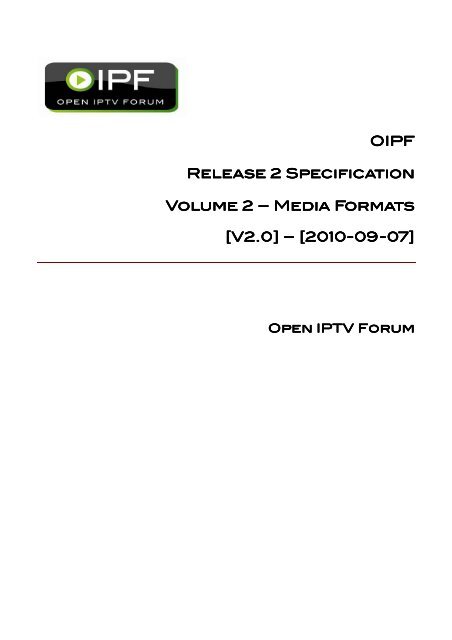
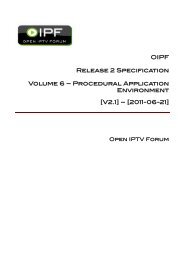

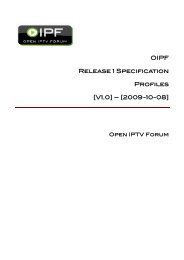
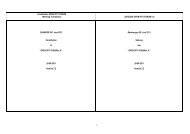



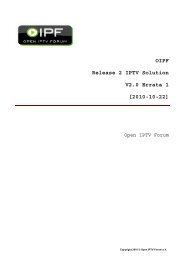

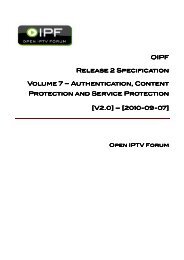
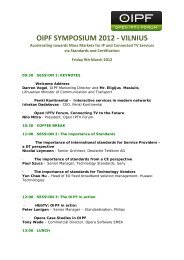
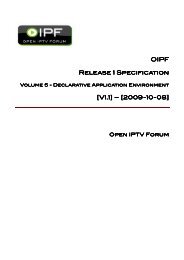
![Overview [V2.0] - Open IPTV Forum](https://img.yumpu.com/30169976/1/184x260/overview-v20-open-iptv-forum.jpg?quality=85)
